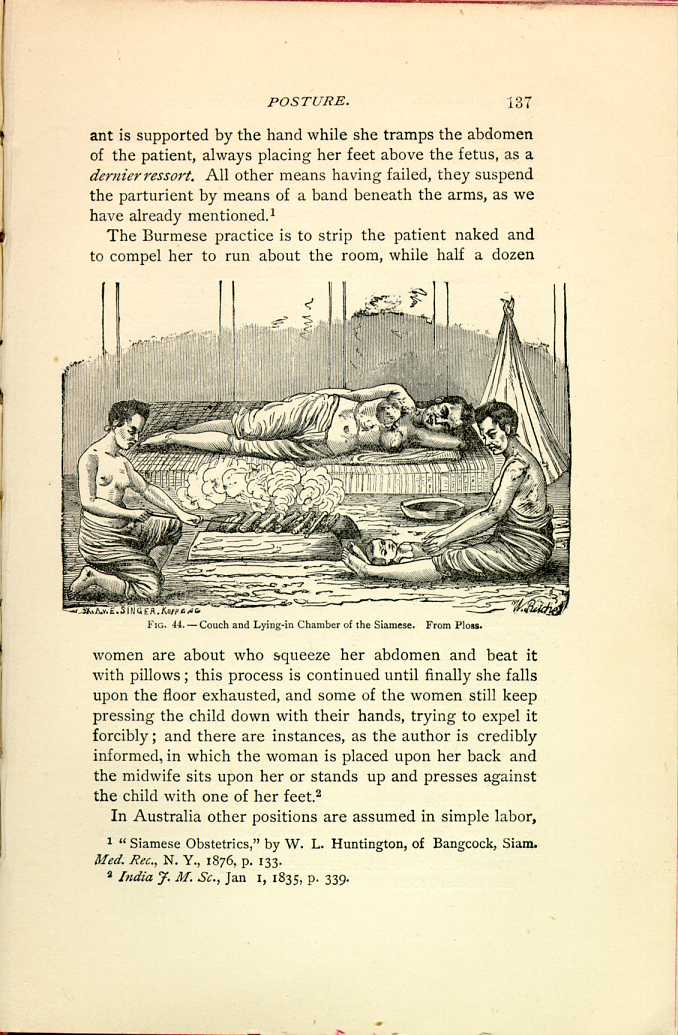| CHAPTER II.
POSTURE IN LABOR. Labor Among Primitive Peoples | ||
1. The Dorsal Decubitus.
The semi-recumbent position held sway in Europe before the time of the obstetric chair, and after a period of great popularity soon disappeared, although its traces remained, especially in the slowly progressing country districts, until
The Chinese women are frequently confined in bed.[129]
Although this is the position which is taught by the laws of modern obstetrics, so perfect in all other respects, nature does not seem to have designed that woman should in this way free herself from her burden; at least it appears very strange that instinct, the correct guide of uncivilized people, should so rarely lead them to adopt the recumbent position; and it appears strange that, notwithstanding the most careful inquiry as to the position adopted by the savages, and notwithstanding the information I have received from surgeons who have come in contact with all of our Indian tribes, I have found scarcely any who assume a strictly recumbent position. Among some the women are confined in the dorsal decubitus, but rarely in the horizontal position. Among the Cheyennes and Arapahoes we sometimes find the dorsal decubitus in simple labors.[130] The Oregon Indians on the Siletz Reservation are invariably confined on the back with the feet drawn up. I am also told that others of the tribes on the Pacific coast follow this custom, especially those of the Grand Ronde Agency, Oregon; the parturient usually keeps on her feet during the first stage of labor, but when the expulsion pains set in she lies on her back, her head very slightly elevated (her bed always on the floor), her thighs well flexed on the abdomen; an assistant supports each knee and foot; the patient presses her hands against her thighs, or, when the pains become severe, she presses
The Nez-Percés and Gros-Ventre squaw assumes the stooping posture during the earlier stages of labor, with an assistant at her back, who clasps her body with her arms, and locking the fingers, brings the palms of the hands over the base of the uterus, making steady pressure backwards and downwards during the pains; in some instances, during the stage of expulsion, however, the patient lies down indifferently on either side or on the back, while if on the side, pressure by the hands of the assistant is kept up continuously, if on the back, the assistant remains by the side of the patient and keeps up the pressure in the before-mentioned directions.
Upon the Antilles the recumbent position is also assumed, though we have seen that other postures are equally common there. Among one of the African tribes, the Wanika, the parturient woman lies flat upon her back, and this is perhaps the only instance where the horizontal position is so decidedly described.[132] Of the Indian women, Susruta says, page 368, "When the child is to be born, let the woman be placed with the back upon a carefully spread couch, giving her a pillow, let the thighs be flexed, and let her be delivered by four steady, aged, and knowing midwives whose nails are well trimmed.''
In Southern India we find a similar custom to that observed among the Nez-Percés; the patient walks about in the earlier stages, then sits down with the legs stretched, her back supported by an assistant, whilst in the moment of expulsion she is placed upon her back.[133]
In Siam the patient is placed upon her back with a woman seated upon either side; these two assistants begin by forcibly pressing the abdomen downward and backward, the pressing of which is continued from three to five hours. If by that time it has failed to expel the fetus, one attendant
The Burmese practice is to strip the patient naked and
to compel her to run about the room, while half a dozen

FIG. 44.—Couch and Lying-in Chamber of the Siamese. From
Ploss.
[Description: Woman reclines on her side on a bed. One attendant keeps a
fire burning nearby, while a second attends the newborn child. Black
and white illustration.]
In Australia other positions are assumed in simple labor,
In Astrakhan the Russian women are made to walk about unceasingly during the earlier stages, and only at the very last moment are permitted to lie down.
In Sumatra, if we may judge from a single case,[137] the patient is also confined in the recumbent position; and in Brazil, according to an old authority cited by Ploss,[138] the native women were confined upon the ground. Several other such vague authorities are cited, but they are hardly sufficiently reliable for our purpose.
| CHAPTER II.
POSTURE IN LABOR. Labor Among Primitive Peoples | ||